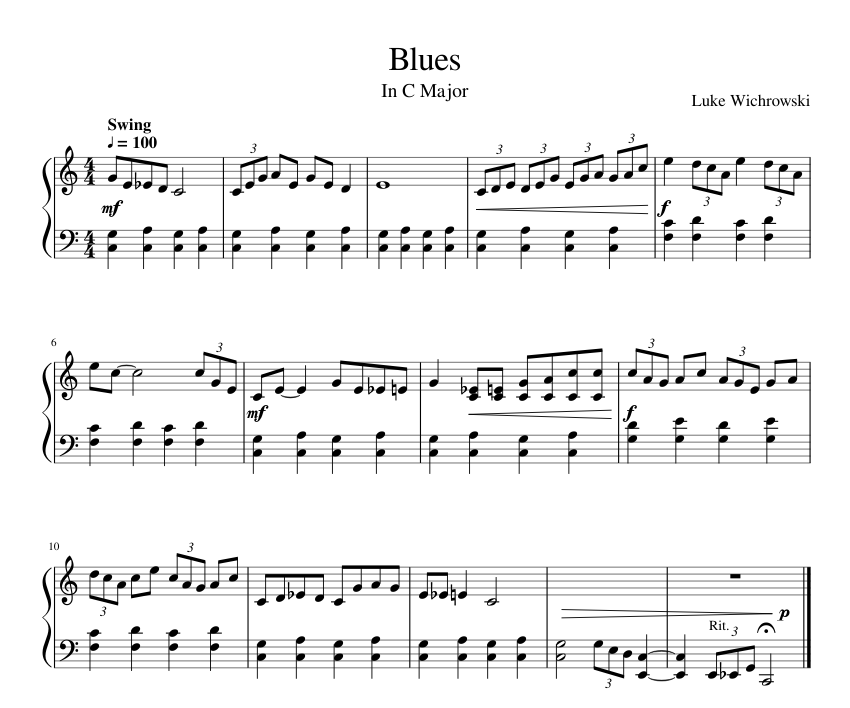
Table of Contents
Playing Blues and Its Basics – Piano Edition
The blues isn't just music, it’s an emotion. A conversation between your heart and your hands. Whether whispered through smoky jazz bars or shouted from festival stages, the blues has carried generations of stories, struggles, and joy. And on the piano, it’s no different.
Even if you're just beginning your piano journey, diving into the blues will unlock a world of feel, groove, and soul. Let’s explore the basics, its rhythm, structure, scales, voicings, and most importantly, how to express yourself.
What Is Blues Piano?
Blues piano grew from the same roots as blues guitar: the African-American experience of the Deep South. It evolved through barrelhouse piano, boogie-woogie, jazz, and rock. On piano, the blues has a broad range—raw and rhythmic like a train (boogie-woogie), or silky smooth and soulful like a slow blues ballad.
Key elements:
- 12-bar blues progression
- Blue notes
- Improvisation
- Groove & swing rhythm
- Call and response phrasing
The 12-Bar Blues: The Framework of Emotion
The 12-bar blues is the heartbeat of the blues. It's a chord structure, repeated in cycles, and gives you room to tell a story.
In the Key of C:
| C7 | C7 | C7 | C7 |
| F7 | F7 | C7 | C7 |
| G7 | F7 | C7 | G7 |

These chords are called dominant 7ths. They create tension and release—just like a story. Let’s break this into three phrases, like a question-answer-call:
Try playing these slowly, using your left hand for simple chords and your right hand for small melodic riffs.
The Blues Scale:
Now, to solo or improvise over the blues chords, you need the blues scale. It’s like a painter’s palette—filled with color and tension.
🎵 The C Minor Blues Scale:
C – Eb – F – Gb – G – Bb – C
Formula: 1 – b3 – 4 – b5 – 5 – b7 – 1
This scale works beautifully over a C7 progression (and its related I–IV–V chords).
Tip: Just take 2-3 notes and play around with rhythm and phrasing. The soul is in how, not how many.
Techniques for Feel: The Real Sound of Blues Piano
Blues isn't about technical brilliance—it’s about soul. Here are key expressive techniques you can use:
- Grace notes: Quickly slide into a note from a half step below (especially black-to-white key slides).
- Crushed notes: Played almost simultaneously with the target note for a gritty, percussive feel.
- Riffs: Short, repeating phrases with strong rhythmic identity.
- Improvised fills: Add between vocal lines or chord changes.
Play a C7 chord in the left, and riff on the blues scale in your right hand—it’ll sound instantly bluesy.
The Shuffle Feel and Swing Rhythm
Blues rhythm often swings. Instead of playing straight 1 & 2 & 3 & 4 &, we play:
Triplet Feel: 1 (trip) - let, 2 (trip) - let...
🎵 Think: DA - da - da, DA - da - da
Here’s how that might look:
Try comping chords in your left hand using this triplet feel—it gives the music a groove that makes people move.
Call and Response: Talking Through the Keys
One of the oldest blues traditions is call and response—borrowed from African musical traditions.
🎹 On piano, it can look like this:
- Left hand “calls” with a riff or bassline
- Right hand “responds” with a lick or phrase
Or:
- One musical phrase is followed by another that answers it rhythmically or melodically.
It’s storytelling through sound.
Essential Blues Chords on Piano
Let’s start with your dominant 7th chords. These are major chords with a flat 7th added.
Basic Dominant 7th Chords:
- C7 = C – E – G – Bb
- F7 = F – A – C – Eb
- G7 = G – B – D – F
Other tasty chords:
- 9th chords: C – E – G – Bb – D
- 13th chords: C – E – G – Bb – A
- Shell voicings: Left hand plays root and 7th; right plays 3rd and extensions.
Learn how to voice these differently up the keyboard—especially using the left hand economically and the right for color.
Learn from the Greats
Want to sound authentic? Listen. Learn. Steal (musically).
- Ray Charles – Blended blues, jazz, and gospel like no one else. Listen: “What’d I Say”
- Otis Spann – Raw and powerful, Muddy Waters' go-to pianist.
- Dr. John – Funky New Orleans piano wizardry.
- Pinetop Perkins – Boogie-woogie master.
Youtube Tutorials for Beginners
Start here:
Jam the Blues (Backing tracks for your jam)
Once you're comfortable with the 12-bar and scales, it’s time to jam.
Start here:
Improvise with 2–3 notes from the C minor blues scale. Focus on timing, repetition, and feel.
Sample Sheet music on Blues in ‘C’

Practice Tips for Beginner Blues Pianists
- Start slow and master one key (like C).
- Record yourself—you’ll hear what the fingers miss.
- Improvise every day, even for 5 minutes.
- Sing along with your right-hand solos—build instinct.
Final Words: Blues is You
At its heart, blues is about honesty. About sharing your story with the simplest of tools: a scale, a groove, a chord. You don’t need to be flashy, just feel it.
Start small. Play slow. And remember, when you play the blues... you’re not just playing notes, you’re telling the truth.
Sam Ashbal Raj J
SME & Trainings
Spardha School of Music
